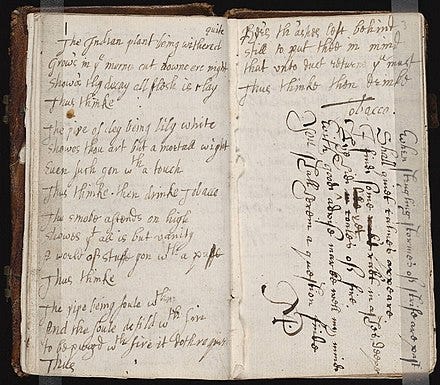Why you should start a commonplace book
How my commonplace system has evolved and my exact process for recording notes, quotes, and thoughts.
I’ve been a long time notetaker, idea collector, and journal-er. Without any sort of system, I used to just keep everything in one notebook—my morning pages, my goal planning, my random notes and thoughts from books, shows, films, and courses…you can imagine how chaotic that got.
For the longest time, I really struggled with how exactly to take notes from the books and media that I would consume. There were so many topics I wanted to record down, each with a ton of learnings I hoped to refer back to.
I decided one day, after flipping through 3 separate notebooks and not being able to find the notes I had taken on a book I wanted to refer back to I decided to create a separate space for recording thoughts. My journey with note-taking started out in the Notes app in our phones. Then went into Notion and then at some point went back to pen and paper. Call me old fashioned but despite being a die hard Notion fanatic, to me notes deserve to live in a notebook. Besides that, the physical act of writing engages more regions of the brain compared to typing, in turn creating stronger neural connection. So quite literally, writing has been proven to help with memory and recall as well! You’ll never change my opinion about it now!
The problem is I couldn’t find a way to organize the notes in a way that makes sense. Keeping everything within one notebook felt messy but keeping individual notebooks for each topic felt impractical. That is until I discovered the art of commonplace notebooks.
What are commonplace books
Commonplace notebooks (or commonplaces) have been a practice of collecting and organizing knowledge, quotes, and insights from various sources in a single notebook since the middle-ages. It serves as a personal repository of wisdom where you can record meaningful passages from books, articles, podcasts, or any other media you consume. The practice has been used by artists, writers, thinkers, students, and scholars as a way to remember specific concept or facts.
There’s some debate over where the commonplace notebook was first mentioned. Aristotle talked about commonplaces in his writing, so did Cicero. Renaissance authors have also been credited for the idea, but I believe Seneca was the first to actually explicitly suggest that readers should keep a collection of their thoughts and sentiments.
I think of my commonplace book as a vault of personal knowledge. In it I collect ideas and quotes that resonated with me, organized in a way that makes them easily accessible when I need inspiration or reference. I know that some people like to organize their commonplaces by topics and themes but I actually just list in the heading of each quote what the theme is.
Tools
I personally use this Leuchtturm A5 dotted notebook with the soft cover. I’ve been using either Moleskine’s softcover notebook or the Leuchtturm hardcover for over a decade now but since I got my beloved Paper Republic leather journal (you can use ANGELPR30 for 30% on their bundles!), I’ve converted to the A5 softcover Leuchtturm because it fits perfectly in my PR portfolio. The pages also bleed less than the moleskine so it works great with my fountain pens.
The pens I use the most often are the Muji 0.5 in dark blue or black ink, and my Lamy Safari fountain pen. I also love this Sailor fountain pen as well.
Organization & indexing


For organization, I started by using the table of contents at the front of the Leuchtturm notebook then converted to using sticker dots to mark each note with a category. I recently read Petya’s article on commonplace journaling and loved her indexing system. She saved the last 5 pages of her notebook to create an index from A-Z and then listing the pages correlating to specific themes.
I definitely took a page out of her book (haha) and decided to try indexing at the back of my notebook as well. Except for me, what I’ve found works is just to create spaces for different themes that I’m exploring (without the alphabetical organization) and then listing the pages.
The beauty of a commonplace notebook lies in its flexibility—you can adapt it to your specific format, needs and interests. Whether you're a writer collecting profound quotes, a student gathering academic insights, or simply someone who loves to learn, a commonplace notebook could be the perfect tool for your thoughts and ideas.
I’ve seen commonplace notebooks organized in a few different ways but the key factors being:
There’s an index or table of contents denoting the categories and topics
Each note you add references where that note came from
Some notes contain your own thoughts about that note as well
I think the beautiful thing about this system is that you can customize it to be uniquely yours. Whether you want to record down verbatim quotes or paraphrases of the content. Whether you want to include your thoughts or just record those of others. Or even if you would rather it be digitized rather than on paper. As long as the main goal of the practice is that you’re saving information that’s useful or stood out to you in some way and then creating a system of categorization to keep it organized—voila! You’ve got a commonplace book.
My commonplace structure
As for the actual format, I found inspiration from a TikToker that makes content around journaling. I love the way she split up her pages so that 70% of the page is kept for recording notes and quotes and 30% is kept for her own annotations and thoughts.
My commonplace book follows the same format: I imagine there’s a vertical line that goes down the page splitting the page into a 30:70 ratio. In the 30% margin, I’ll write the title of the book/video/resource that I’m taking notes from as well as little notes about why it resonated or my own opinion on the matter. The rest of the page will be used to save down quotes and notes, each denoted with a page number or sometimes even video minute.
Here’s my process:
As I’m reading, watching, listening if there’s a quote I want to remember, I’ll jot it down in my commonplace notebook along with the source as well as the content time or page number
I’ll continue to do this as I go through whatever it is I’m consuming
In the margins I’ll start writing down themes. It could be as simple as “on creativity”, “on identity”, “on style”, etc.
I’ll denote a little triangle (also in the margins) for adding my own thoughts. That way I when I skim through a page I can quickly look at what the theme was and my thought on it.
my thoughts usually include
how this relates to me
why I write it down
feelings and emotions it triggered
a quick summary in my own words
To index that note, I’ll flip to the back of my notebook and look at the topics I’ve saved. If it fits into one of the topics, I’ll jot the page number down next to it. If it doesn’t, I’ll think about whether it’s a new topic I should add or whether there’s a bigger, overarching theme that would make more sense. If there is, I’ll create a new section in the index for it.
When I’m writing a newsletter, creating a video, or journaling about something and I want to pull a quote or have some supporting thoughts, I’ll flip through my index to see if there’s anything that relates
Sometimes I’ll even just flip through my commonplace book for inspiration. Reading the quotes, notes, and thoughts I’ve saved can trigger a new idea for creation
That’s it! I keep my commonplace book simple but organized. I’m loving this system so far and I think it’s the easiest way for me to be able to look back and find what I need.
Because I’m nosy, I love seeing other people’s commonplaces. If you have one, please share a photo in the comments!
Read my recent journaling post next:










This piece was so inspiring! You made the idea of a commonplace journal feel so approachable, and I really appreciate that. I’ve always loved the concept, but I found it a little daunting for some reason.
This year, I decided to streamline my journaling by carrying just one catch-all notebook instead of rotating between multiple ones. I love it so far, but I already know that finding specific things later on will be a challenge. So, I’m treating this as a trial—figuring out what I naturally gravitate toward recording, spotting patterns, and establishing themes. I think that will help me create a more intentional system down the line.
I’m saving your article because I know I’ll come back to it—it’s such a great resource! And thank you for sharing the Paper Republic journal; it’s absolutely gorgeous. Now I’m curious—how do you use your other notebooks? I noticed you labelled your Leuchtturm as a Morning/Commonplace Journal—would love to hear more about how you differentiate the other ones!
Love this! Also maybe it’s algorithm but it’s crazy how you appeared just on my YT feed yesterday and today I stumbled upon you here 🥹
I also keep a commonplace book but I decided to drop the indexing. Since I use a much smaller field notes pocket book, it’s not too overwhelming to just find what I’m lookin for, it also feels a bit like an adventure trying to make sense of my messy brain that’s drawn to so different themes across time. But I love your approach and find it so inspirational.